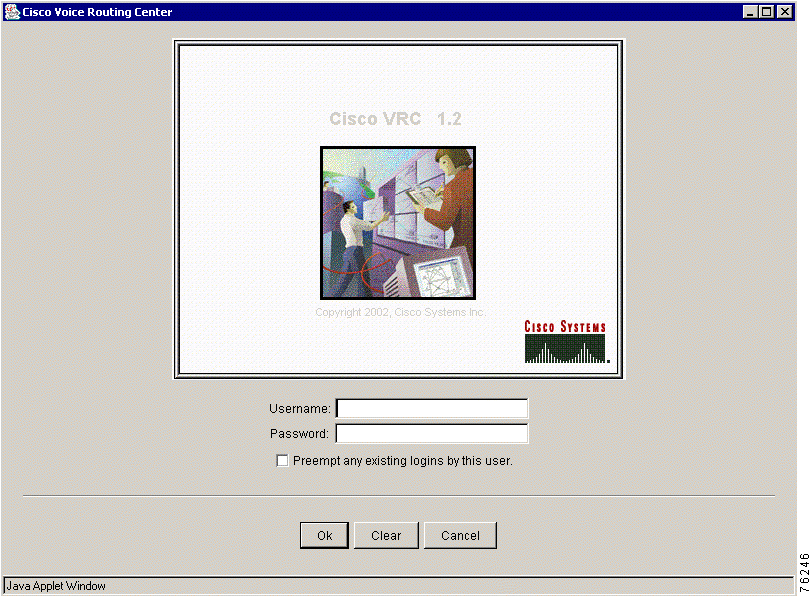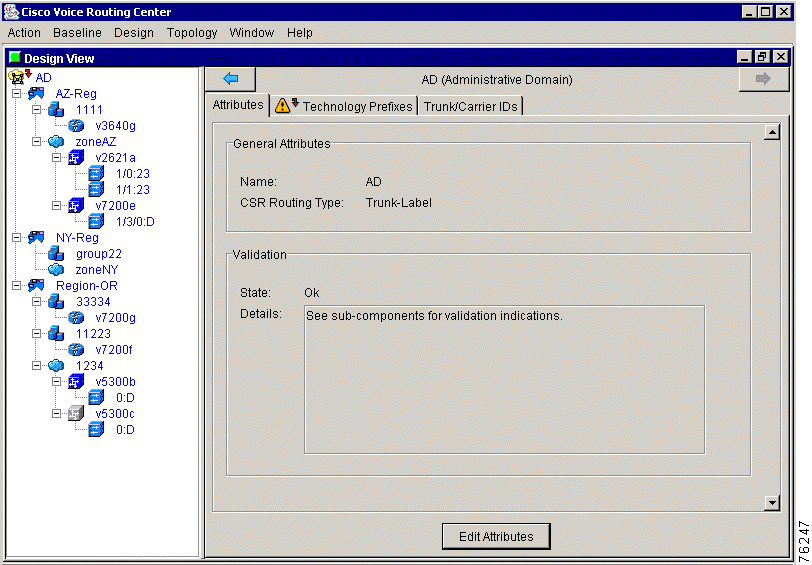|
|

This chapter contains the following topics:
The Cisco Voice Routing Center (VRC) client is provided as web pages accessed with a web browser. When VRC:
This section describes how to use the VRC client.
Before you begin, read the following tips for troublshooting client operations:
To log in to VRC through the client, follow these steps:
Step 1 Open the Internet Explorer browser and enter the following URL:
http://<server name or IP address>:8080/VRC
The server name is the host name where the VRC server software is running.
Step 2 Minimize the browser window.
The VRC login window appears (Figure 3-1).

Step 3 Enter your Username and Password and click OK.
Step 4 Check the box if you want your login to preempt any previous logins by this same user.
Step 5 Click OK. The Cisco Voice Routing Center window appears (Figure 3-2).

Step 6 Choose your operation from the VRC menus.
To log out of the VRC client, follow these steps:
Step 1 To exit from the VRC client, choose Exit from the Action menu and click OK.
Step 2 To exit from the browser window, restore your browser window, and choose Close from the File menu.
Use this procedure to view the privileges for each user account from the client. You can view user privileges in any view when you choose Show Privileges from the Action menu.
This window displays the type of privilege and scope for each user.
You can display a user log from any view when you choose Display User Log from the Action menu. The user log is displayed in a separate browser window.
Use this procedure if you are in the VRC client and you want to change a user password. This menu action from the VRC client takes you directly to the CNS security service user interface. User administration for VRC is managed by the CNS security service. See "Changing a User Password from CNS."
You can change a password from any VRC view when you choose Change Password from the Action menu.

To obtain access to VRC from the PTC user interface, click the Voice Routing Center button on the PTC Launch Pad window and begin using VRC. For detailed information, see "Cisco VRC Integrated with PTC."
This section describes the VRC menus (see Figure 3-2).
The following menu items are described:
This section provides you with a quick overview of the Voice Routing Center and lists the first steps to take when you use the VRC to open an existing dial plan or to create a new dial plan.
The VRC is designed so that a user can make dial plan changes for the whole network (Administrative Domain (AD)), or only within a partition of the network (region). There can only be one design session open per region. The advantage of regional administration is that multiple users can concurrently be doing regional designs.
Only one user at a time can do AD level designs and that design session blocks all regional design sessions.
This section describes a quick start for:
 |
Note For detailed information about each task, refer to the appropriate sections in this user guide. |
The following tasks provide a quick start for creating a new dial plan:
1. Add your elements to the topology by using batch import or by manually adding each element to the topology in the Topology View. If you are using VRC integrated with PTC, add the elements using the PTC Topology Manager. In either case, if an element is not present in the topology then it cannot participate in the dial plan.
2. Start a new design session.
3. Add your elements to the design session dial plan.
4. Configure zones, routes, gatekeeper groups, and directory gatekeeper groups as desired.
5. Use the Validate operation to identify any inconsistencies and errors in the dial plan. See "Troubleshooting Cisco VRC" to help you correct any errors. Refer back to Step 4 to make corrections to your configurations.
6. Commit your design session to establish a baseline dial plan. After you commit a dial plan design, you are advised of the elements that receive a new configuration CLI. You can also preview the configuration CLI for those elements.
The following tasks provide a quick start for creating a new dial plan by discovery:
1. Add your elements to the topology by using batch import or by manually adding each element to the topology in the Topology View. If you are using VRC integrated with PTC, add the elements using the PTC Topology Manager. An element must exist in the topology to participate in the dial plan.
2. Execute a discovery of the network at the Administrative Domain (AD) level. VRC uses this information to establish a baseline dial plan. If there are any problems with the dial plan from VRC's perspective, you receive error, warning, or informational messages. See "Troubleshooting Cisco VRC" to help you correct any errors.
3. Make the necessary corrections to your configurations. View the generated CLI for any element to determine if your corrections achieve the expected result.
4. Use the Validate operation to identify any inconsistencies and errors in the dial plan. See "Troubleshooting Cisco VRC" to help you correct any errors. Refer back to Step 3 to make corrections to your configurations.
5. Commit your design session to establish a baseline dial plan. After you commit a dial plan design, you are advised of the elements that receive a new configuration CLI. You can also preview the configuration CLI for those elements.
The following tasks provide a quick start for starting a new dial plan design:
1. Add your elements to the topology using batch import or by manually adding each element to the topology in the Topology View. If you are using VRC integrated with PTC, add the elements using the PTC Topology Manager. An element must exist in the topology to participate in the dial plan.
2. Start a new design. The baseline dial plan, which is the last committed dial plan design, is displayed.
3. Configure zones, routes, gatekeeper groups, and directory gatekeeper groups as desired.
4. Use the Validate operation to identify any inconsistencies and errors in the dial plan. See "Troubleshooting Cisco VRC," to help you correct any errors. Refer back to Step 3 to make corrections to your configurations. View the generated CLI for any element to determine if you achieved the expected result.
5. Commit your design session to establish a baseline dial plan. After you commit a dial plan design, you are advised of the elements that receive a new configuration CLI. You can also preview the configuration CLI for those elements.
The following tasks provide a quick start for opening an existing dial plan design:
1. Open an existing design. Choose a previously saved design file.
2. Configure zones, routes, gatekeeper groups, and directory gatekeeper groups as desired. Any new element must be added in the topology before you can add it to the dial plan.
3. Use the Validate operation to identify any inconsistencies and errors in the dial plan. See "Troubleshooting Cisco VRC," to help you correct any errors. View the generated CLI for any element to determine if you achieved the expected result.
4. Commit your design session to establish a baseline dial plan. After you commit a dial plan design, you are advised of the elements that receive a new configuration CLI. You can also preview the configuration CLI for those elements.
![]()
![]()
![]()
![]()
![]()
![]()
![]()
![]()
Posted: Wed Oct 2 14:30:56 PDT 2002
All contents are Copyright © 1992--2002 Cisco Systems, Inc. All rights reserved.
Important Notices and Privacy Statement.